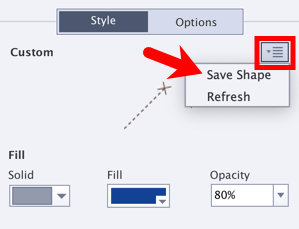Captivate gives you the ability to save your custom shapes and add them to the list of predefined shapes. In this exercise, you will save your custom shape and insert a second instance of it via the following steps:
- In slide 2 of your project, make sure that your custom shape is selected (with white selection handles around it).
- Locate the Custom section at the very top of the Style tab in the Properties inspector.
- Click the icon in the top-right corner of the Custom section and choose the Save Shape item, as shown in the following screenshot:

- Type myShape into the Rename Item dialog and click OK to save your custom shape.
By saving your custom shape, you make it a part of the collection of predefined shapes, so you can reuse it in the future. Perform the following step to draw a second instance of the same shape.
- Click the Shapes icon on the toolbar to open the Smart Shapes panel.
Note that your new shape is present in the Recently Used Shapes section at...



